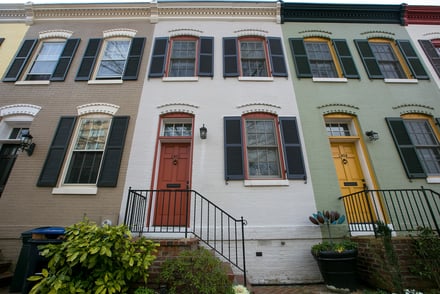 Replacing the windows of a historic brick home in Washington, D.C. is about more than energy efficiency. It is also about aesthetics, maintaining character and staying in compliance with local historic preservation guidelines. Before jumping into your window replacement project, it’s important to consider a few key factors that will help you make the right decision for your home.
Replacing the windows of a historic brick home in Washington, D.C. is about more than energy efficiency. It is also about aesthetics, maintaining character and staying in compliance with local historic preservation guidelines. Before jumping into your window replacement project, it’s important to consider a few key factors that will help you make the right decision for your home.
Know the Rules of Your Historic Neighborhood
1. Know the Rules of Your Historic Neighborhood
Before making the decision to get new windows, determine if your home is located in one of D.C.’s or Alexandria’s historically designated areas. In these neighborhoods, you may be limited in the types of materials you can use for window replacements or the styles you can choose from. Additionally, there are often different rules governing different floors of houses, as well as street-facing versus back windows.
Specific rules also govern how new windows must fit into the existing window opening. While it’s tempting to skip this step because you see an unmatched window at a neighbor’s house, don’t do it. Those windows would likely need to be brought into compliance if they were changed out under today’s rules. Checking these regulations ahead of time helps prevent costly mistakes and ensures you comply with local historic preservation standards.
2. Use Wintery Weather to Your Advantage
Winter is a good time to check out the trends in print or online magazines and architectural websites. Once you have a feel for what you’d like, winter can be an excellent time to visit local window manufacturers and contractors. You’ll likely have plenty of individualized attention, and booking window installations now for the spring gives you a better selection of dates and shortens the timelines for project completion.
Another advantage of considering new windows in the winter is how cold, blustery weather can make it easier to identify drafts and energy inefficiencies in your current windows, giving you a clear picture of what needs improvement. You will better understand your major window concerns and may find that repairing the historic window is just as suitable as replacing it.
3. Understand How R-Value Impacts Your HVAC Bills
Over the years, your historic brick home’s windows may not perform as well as they used to, leading to drafts, higher energy bills, UV exposure and other inconveniences. Energy efficiency is one of the leading reasons for window replacement, but there are other considerations.
R-value measures thermal resistance; the higher the R-value, the better your home retains heat in winter and keeps the heat out in summer. Low-emissivity (LoE) coatings are another factor to consider, as blocking UV light can offer improved insulation and reduce harmful UV radiation that can fade floors, furniture and artwork.
However, you can often improve the R-value of existing windows without a complete replacement. Storm windows, weatherstripping, caulking and repairs can all enhance thermal performance and improve your home’s indoor climate.
4. Seek Professional Guidance
New windows are a significant, long-term investment; an experienced window installation company can help guide you through the process. Additionally, consulting with historic brick home experts can help ensure that the bricks around the window (and the window sills) are in suitable condition, and that any security bars or other features are removed and put back safely and correctly. The experts will ensure your replacement windows look great for years.
For questions about window repair vs. replacement, window sills, or other inquiries about your old brick home in D.C. or the surrounding region, contact Renaissance Development to arrange a consultation. We will help you find the best solution.
Tags:
Window Shutters, historic brick home, historic brick, Windows, Historic Windows, Repairing or Replacing Old Windows, Historic Brick Home DC, Window sills, Window frames2/6/25 8:30 AM


